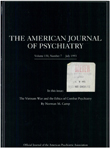Psychotherapist-patient sexual contact after termination of treatment: an analysis and a proposal
Abstract
Controversy over the legitimate extent, if any, of sexual contact between psychotherapists and former patients remains intense. In this paper the authors review current approaches to controlling posttermination sexual contact, offer a conceptual framework within which the problematic aspects of therapist-patient sex both during and after treatment can be understood, and develop a set of recommendations for policies that balance the goals of protecting former patients and avoiding unnecessary interventions into consensual relationships. Review of ethical, legal, and administrative controls on posttermination sex revealed considerable heterogeneity of approaches, which appeared to be based on confusion concerning the rationale for restriction. An analysis of the problems with therapist-patient sexual contact suggests four areas of concern: impaired decision making, coercion, fraud, and exploitation of a fiduciary relationship. The nature and magnitude of these problems differ in pre- and posttermination sexual relationships. The authors conclude that clarity of restrictions on posttreatment sex is important, but an absolute ban is not essential to protecting former patients. Rather, a 1-year waiting period after termination, during which even social contact would be precluded, should minimize problems and allow former patients and therapists to enter into intimate relationships. The authors discuss the advantages and disadvantages of this approach over other approaches.
Access content
To read the fulltext, please use one of the options below to sign in or purchase access.- Personal login
- Institutional Login
- Sign in via OpenAthens
- Register for access
-
Please login/register if you wish to pair your device and check access availability.
Not a subscriber?
PsychiatryOnline subscription options offer access to the DSM-5 library, books, journals, CME, and patient resources. This all-in-one virtual library provides psychiatrists and mental health professionals with key resources for diagnosis, treatment, research, and professional development.
Need more help? PsychiatryOnline Customer Service may be reached by emailing [email protected] or by calling 800-368-5777 (in the U.S.) or 703-907-7322 (outside the U.S.).



